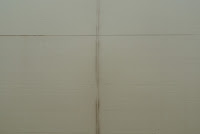Given the confusion, I thought it best to review some of the images published on Miksang sites run by authorized teachers. If any images might offer a clue, it might be these.
To the right is a screen shot from the Space gallery at Seeing Fresh, a website to promote Andy Karr's Contemplative Photography, a somewhat secularized copy of Miksang from a Miksang student. The gallery features images submitted by students but selected by whoever runs the site, presumably Mr Karr or someone authorized by him.
What strikes me most about the collection is that nearly all the images have a clearly noticeable anchor. They might contain a lot of sky or grass or wall, but in nearly all these images the eye falls on the bird, the kids fishing, a leaf, laundry flying in the breeze. I would think these are better examples of dot-in-space, rather than space itself. The only one that seems remotely space-like, with little for the eye to hold on to, is the top left image of water, though even here we get a nice bit of contrast to help the mind engage. The leaves in the water are small enough that the mind doesn't fall on any one.
Following is a collection of space images from the gallery of the Miksang page of authors McQuade and Hall.
What do these images have in common?
- Limited tonal pallet.
- Dependence on line or pattern.
- Lack of context masking the size of the content, and sometimes the content itself. The two images at bottom are (left) the seams in a concrete wall, and (right) automobile exterior detail. The actual size of the snow drift (top) is unclear.
I wonder if the following, selected from my image collections, might be considered expressions of space.
#















No comments:
Post a Comment